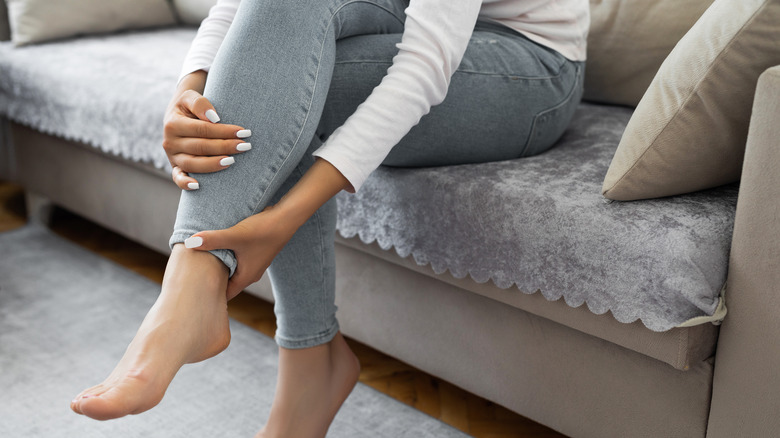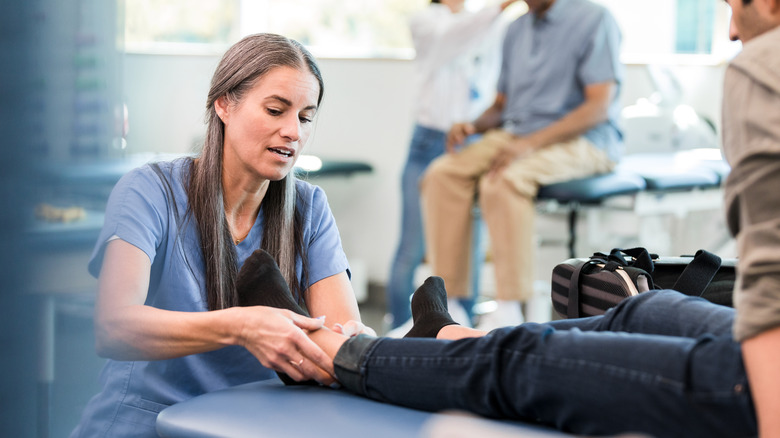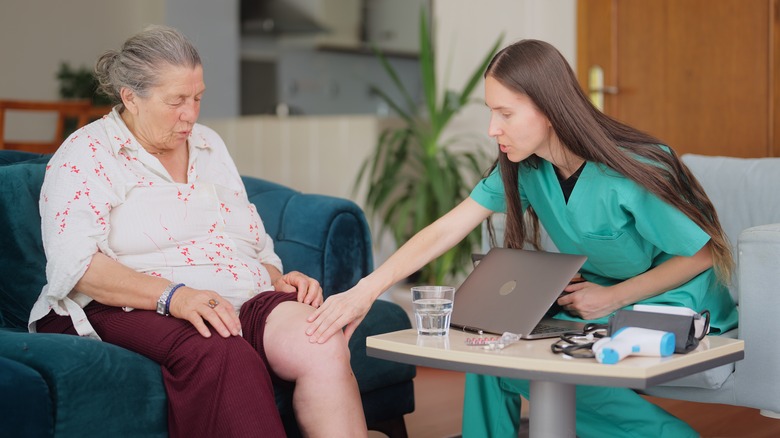Health Warnings Your Legs Are Trying To Tell You
Your body often gives clues about your overall health. That can be a good thing so you can seek treatment for certain conditions before it's too late. Things like chapped lips could be a sign of simple dehydration or a serious infection. The color of your urine can tell you if you have a kidney or liver injury. Your eyes can reveal things like whether you might have signs of multiple sclerosis. Skin problems can point out a poor diet or a hormonal disease.
Your legs can also tell you something about your health. While a tough leg day at the gym could make your muscles tired for days, your legs could also hurt even if you don't work out. Your feet could swell up if you sit on a barstool and wash down a plate of Buffalo wings with a beer or two. Sometimes you could feel an itchy sensation in your legs at night, or you could have times when you don't feel your legs at all. All of these symptoms could point to something minor or temporary about your health, or certain symptoms could be telling you of a more serious condition.
Restless legs syndrome causes itchy, crawling legs
Throbbing, itchy, or crawling sensations in one or both legs might be due to a neurological disorder called restless legs syndrome (RLS). RLS often occurs later in the day or while you're trying to sleep, and your sensations can go away if you move your legs. You also might not notice these sensations early in the morning, and symptoms of RLS might only occur once or twice a week.
Restless legs syndrome is both a sleep disorder and a movement disorder. It can affect up to 10% of people at some time in their lives, according to the National Institutes of Health. RLS is more likely to occur in middle age or later. You could also develop RLS if you're sleep-deprived or use drugs like alcohol, nicotine, or caffeine. Some antidepressants, antihistamines, and other medications could exacerbate RLS. Treating RLS could involve taking iron supplements, opioids, or benzodiazepines, but milder cases of RLS can be treated with regular exercise, leg massage, and healthy sleep patterns.
Peripheral artery disease causes leg pain during exercise
Pain in your calves, thighs, and butt when you exercise could signal peripheral artery disease. This pain is different from pain resulting from exercise because the pain goes away when you're at rest. Peripheral artery disease might also show up as cold legs or feet. You might also notice the hair on your legs stops growing or cuts on your legs take longer to heal.
Peripheral artery disease results from fatty plaque building up in your arteries. This can turn into coronary artery disease when these plaques clog the arteries to your heart. The fatty buildup blocks the flow of blood and oxygen to your legs. Peripheral artery disease doesn't show up in your legs quickly. Gradually, you might feel more pain as the blockages develop.
Your doctor might recommend a treatment plan including a healthy diet and exercise. Smoking can exacerbate artery disease, and cutting back on alcohol can benefit your heart and arteries.
Swelling in both legs could be edema
It's one thing when your ankle or knee becomes swollen when you're injured, but swelling in your ankles, feet, or entire legs could be a sign of edema. Edema occurs when you have too much fluid in your tissues. Pressing into the swelling might leave a dent, and your joints might be difficult to move. You could develop edema overnight if you've eaten too much sodium the day before or you've been seated for a long time. This type of edema, which is due to fluid retention, is temporary and goes away.
However, chronic swelling in your legs could be a sign of a more serious condition. Heart failure can cause edema because the heart isn't strong enough to pump blood efficiently. That causes blood to pool in your lower limbs. Edema occurs more often in the later stages of heart failure. Swelling in your legs can also occur with kidney disease as the kidneys can't filter out waste from your body. As a result, these fluids settle into your tissues.
Swelling in one leg could be deep vein thrombosis
If you feel throbbing in your calf or thigh when you're moving, see if it's in one or both legs. Also, notice if your veins are swollen and tender to the touch. Swelling, red, or warm skin in one leg could indicate deep vein thrombosis. Deep vein thrombosis is a blood clot in one of your veins, and it requires emergency attention because this blood clot could move to your lungs.
You could be at risk for deep vein thrombosis if you're over 60, overweight, smoke, or have varicose veins. People with cancer or heart failure are also at risk for deep vein thrombosis. Contraceptives and hormone replacement therapy also put you at risk for deep vein thrombosis.
Sometimes, your circumstances can put you at risk for a blood clot in your leg. Any time you're confined for long periods, such as in a hospital bed or on an extended plane or car ride, this could increase your likelihood of developing deep vein thrombosis. That's why moving around often while you're traveling is important. Staying active and adequately hydrated can also lower your risk of deep vein thrombosis.
Burning or numbness could be diabetic neuropathy
It's one thing if your foot falls asleep after sitting in the same position for a while, but it's another issue when this tingling or numbness occurs at other times. People with diabetes could experience diabetic neuropathy as high blood sugar begins to damage the blood vessels that feed the nerves. Diabetes eventually damages the nerves as they lose vital nutrients.
At first, you could feel tingling or burning in your hands or feet, but neuropathy can spread to your legs and arms as more nerves become damaged. You might not feel numbness all the time and you're more likely to feel it at night. You're more at risk for developing diabetic neuropathy the longer you have diabetes and if you also have conditions such as high blood pressure, vitamin B deficiency, or kidney disease.
If you're experiencing numbness in your legs and aren't being treated for diabetes, be sure to see your doctor to have your blood sugar and cholesterol checked. You can prevent diabetic neuropathy by staying active and eating a diet that keeps your blood sugar and cholesterol under control. People with diabetes have to pay careful attention to their feet by wearing appropriate footwear to protect them and maintain circulation.






